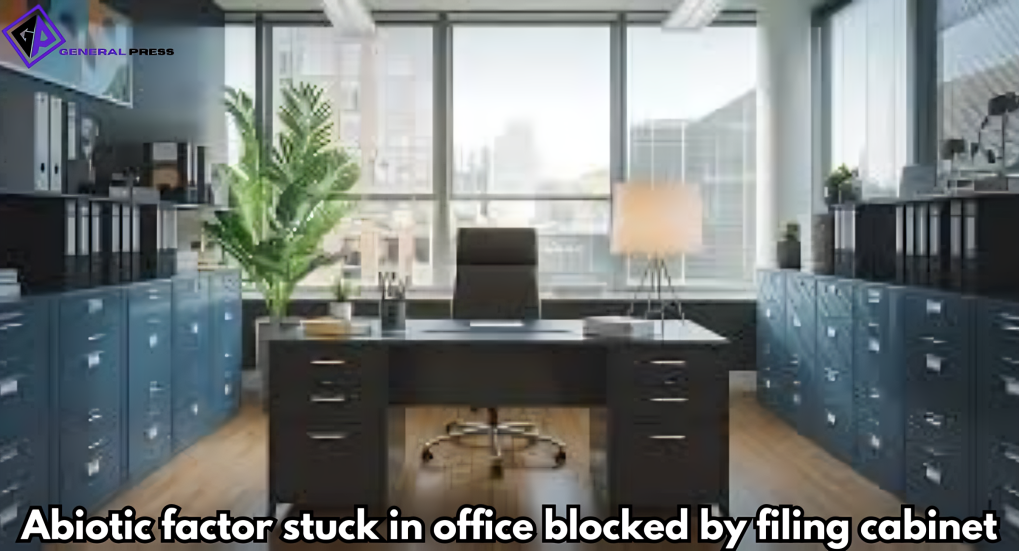When we think about abiotic factors, our minds often wander to natural environments such as deserts, forests, or oceans. These non-living components, including temperature, light, water, and soil, significantly influence ecosystems and the survival of living organisms. But what happens when we introduce a decidedly unnatural twist to the concept of abiotic factors—an office setting where a metaphorical or literal “abiotic factor” finds itself blocked by a filing cabinet? Let’s delve into this unusual scenario and unpack its implications, both metaphorically and practically.
Abiotic Factors Defined
Abiotic factors are the physical and chemical elements of an environment that shape the lives of organisms within it. In natural ecosystems, these factors include sunlight, humidity, air quality, pH levels, and even the texture of soil. They interact with biotic factors—living organisms like plants, animals, and microbes—to create dynamic systems. The balance between these components is crucial to sustaining life.
In an office, the term “abiotic factor” can be reimagined. Here, non-living elements such as artificial lighting, air conditioning, office furniture, and even filing cabinets become part of the environmental landscape. These elements can influence productivity, comfort, and overall morale, much like their natural counterparts affect ecosystems.
The Filing Cabinet Dilemma
Also Read: John Teets Net Worth: A Glimpse into the Legacy of a Business
Imagine an abiotic factor—perhaps a beam of sunlight streaming through a window—attempting to illuminate an otherwise dreary office but finding itself blocked by a filing cabinet. While this scenario might seem whimsical, it raises significant questions about how non-living elements in the workplace interact and impact human experiences.
Practical Consequences
In practical terms, a filing cabinet blocking sunlight in an office can create several issues:
- Reduced Natural Light: Sunlight is a vital abiotic factor for human well-being. Exposure to natural light has been shown to improve mood, boost vitamin D levels, and enhance productivity. A blocked window deprives employees of these benefits, leading to a dimmer and potentially more stressful work environment.
- Temperature Regulation: Sunlight also helps regulate indoor temperature. Blocking it with a heavy object like a filing cabinet may make certain areas colder, increasing reliance on artificial heating systems.
- Aesthetic and Psychological Effects: A well-lit office feels more open and inviting. Conversely, a shadowy, cluttered space can contribute to feelings of confinement and disorganization.
Symbolic Interpretations
Metaphorically, the scenario could represent workplace obstacles or inefficiencies. The filing cabinet—a symbol of bureaucracy, storage, and sometimes inertia—could signify the challenges that block progress or creativity. The sunlight, an abiotic factor, might represent clarity, innovation, or external influences attempting to penetrate the confines of a structured office setting.
The Interplay Between Abiotic and Biotic Factors in Offices
Just as abiotic factors shape natural ecosystems, their office counterparts influence the behavior and productivity of employees (the biotic factors). Here are some examples:
- Air Quality: Clean air is essential for health and concentration. Poor ventilation—an abiotic shortfall—can lead to fatigue and reduced cognitive function.
- Temperature: Offices that are too hot or too cold can create discomfort and reduce efficiency. Temperature control is an abiotic factor that must be carefully managed.
- Lighting: Both artificial and natural light play critical roles. Bright, well-balanced lighting fosters alertness, while dim or overly harsh lighting can strain eyes and dampen morale.
Balancing these abiotic factors ensures a healthy and productive workplace, much like maintaining equilibrium in a natural ecosystem.
Solutions to the Filing Cabinet Conundrum
To address the specific issue of a filing cabinet blocking sunlight, consider the following steps:
- Reevaluate Office Layout: Assess the placement of furniture and identify areas where natural light can be maximized. Rearranging heavy objects like filing cabinets can make a significant difference.
- Embrace Minimalism: Decluttering and reducing reliance on bulky furniture can free up space and create a more open environment.
- Use Mirrors and Reflective Surfaces: If relocating the filing cabinet isn’t an option, mirrors or light-colored walls can help distribute sunlight throughout the room.
- Introduce Biophilic Design: Incorporate elements of nature, such as indoor plants and natural materials, to compensate for the blocked sunlight. This approach can improve mental well-being and create a connection to the outdoors.
A Broader Perspective
The concept of an abiotic factor being “stuck” or hindered in its influence isn’t limited to offices. It can serve as a metaphor for broader societal challenges. For example, urbanization often blocks access to natural abiotic factors like fresh air and green spaces, impacting public health. Similarly, industrialization may obstruct sunlight or clean water in certain regions, disrupting local ecosystems.
By examining how abiotic factors are obstructed—whether by filing cabinets or larger structural forces—we can better understand the importance of thoughtful design and planning in any environment.
FAQs:
1. What is an abiotic factor?
An abiotic factor refers to the non-living elements in an ecosystem that influence living organisms. These can include sunlight, temperature, water, air, minerals, and soil. Essentially, they are the environmental factors that impact the living organisms in a specific area.
2. How does the concept of an abiotic factor relate to being “stuck in an office”?
The phrase “abiotic factor stuck in office blocked by filing cabinet” appears to be a metaphor or humorous description. The “abiotic factor” could refer to a situation where something in the office environment is blocking or hindering movement or access, such as a filing cabinet preventing you from reaching a necessary resource (like light, temperature control, or other environmental factors).
3. Why is my office environment considered an “abiotic factor”?
In your office, factors like lighting, air quality, temperature, and humidity are considered abiotic because they are non-living components of your workspace that can affect your comfort and productivity. These are examples of abiotic factors that influence your daily life at work.
4. What should I do if my filing cabinet is blocking access to important work items?
If your filing cabinet is physically blocking access to essential resources, consider reorganizing your office layout. You could move the filing cabinet to a more suitable location, declutter unnecessary items, or optimize your workspace to ensure better flow and easier access to important materials.
5. Is there any connection between abiotic factors and office productivity?
Yes, abiotic factors in your office, such as lighting, temperature, air quality, and noise, can significantly influence your productivity and well-being. Poor lighting or uncomfortable temperatures can reduce focus and efficiency, while a well-organized space with favorable conditions can enhance performance.
Conclusion
The peculiar image of an abiotic factor stuck in an office, blocked by a filing cabinet, invites us to reflect on the interplay between non-living and living elements in our daily lives. Whether taken literally or metaphorically, it highlights the significance of maintaining harmony in our environments. Just as natural ecosystems thrive on balance, so too do our workplaces and communities. By addressing obstacles and embracing the potential of abiotic factors, we can create spaces that nurture both productivity and well-being—and perhaps even let a little more sunlight in.




